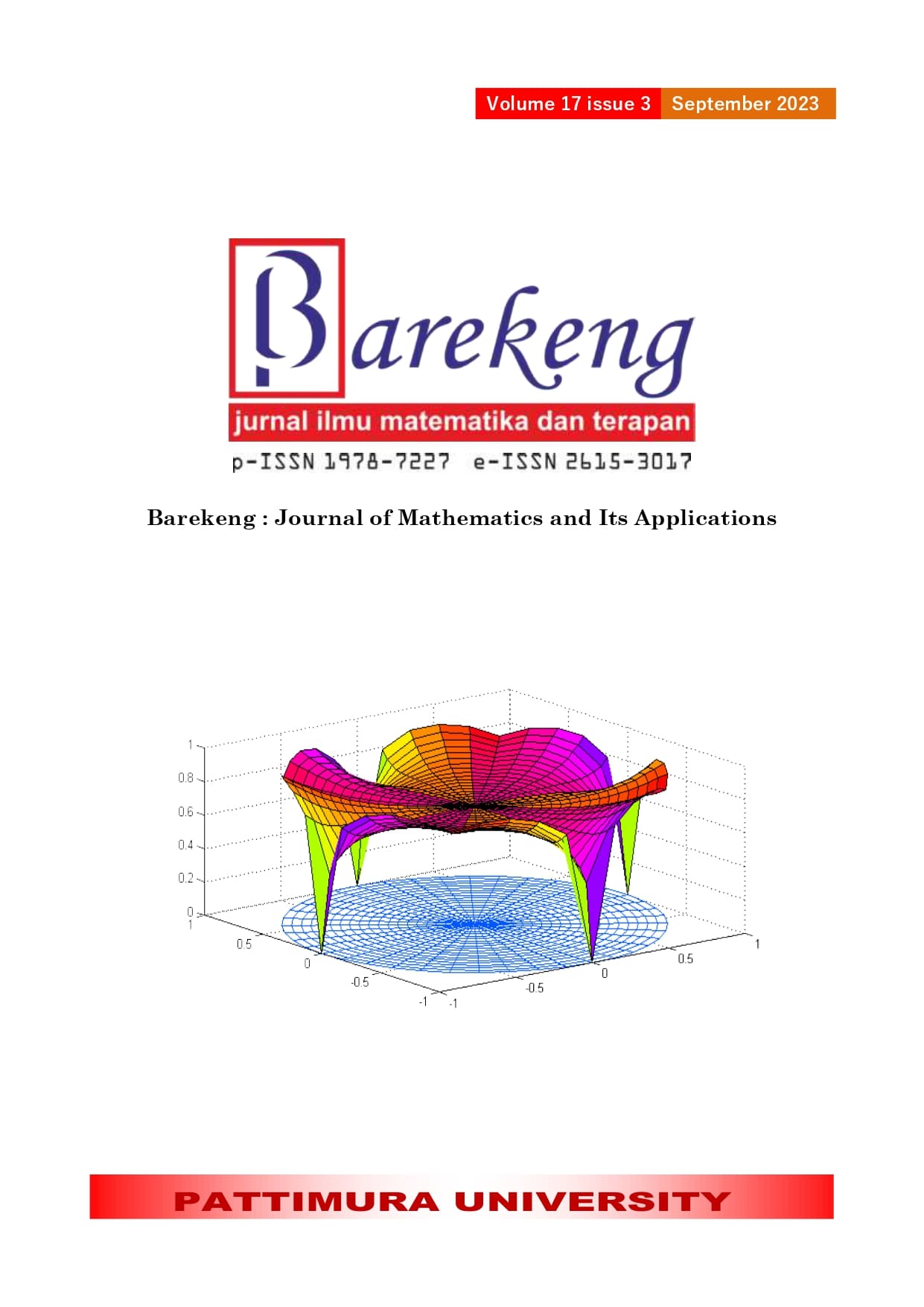MODELING CLUSTERWISE LINEAR REGRESSION ON POVERTY RATE IN INDONESIA
Abstract
When a person's income is so low that it cannot cover even the most basic living expenses, they are said to be poor. Data on poverty levels and hypothesized causes are used in this study. If the data pattern forms clusters, one of the regression analyses that can be used is Clusterwise Linear Regression (CLR). Therefore, this study aimed to determine the poverty rate modeling in Indonesia with the CLR method. The results showed that the best model is with 3 clusters, that for cluster 1, the factors that significantly affect the percentage of poverty are the percentage of electricity users , the number of small and micro industries and the number of tourist villages n cluster 2, the amount of village tours . In cluster 3, the percentage of users of electricity and the percentage of villages that have mining and quarrying .
Downloads
References
M. J. Pandu, “Pemodelan Persentase Kemiskinan di Provinsi Nusa Tenggara Timur dengan Menggunakan Model Ekonometrika Spasial Data Panel Dinamis,” Thesis, Institut Teknologi Sepuluh Nopember, Surabaya, 2016.
P. S Gopal, M. A. Abdul Rahman, N. M. Malek, P. S. Jamir Singh, and L. Chee Hong, “Kemiskinan Adalah Satu Fenomena Multidimensi: Suatu Pemerhatian Awal,” Malaysian J. Social Sciences Humanities (MJSSH)., vol. 6, no. 1, pp. 40–51, 2021, doi: 10.47405/mjssh.v6i1.608.
E. H. Jacobus, P. Kindangen, and E. N. Walewangko, “Analisis Faktor-faktor yang Mempengaruhi Kemiskinan Rumah Tangga di Sulawesi Utara,” J. Pembangan Ekonomi dan Keuangan Daerah., vol. 19, no. 3, pp. 86–103, 2018.
M. Ramdani, “Determinan Kemiskinan di Indonesia Tahun 1982-2012,” Economics Development Analysis Journal., vol. 4, no. 1, pp. 58–64, 2015.
BPS, “Profil Kemiskinan di Indonesia September 2020,”. Jakarta: Badan Pusat Statistika, 2021.
A. Husniyah, N. A. Basyah, and A. Mustofa, “Dampak Usaha Mikro Kecil dan Menengah ( UMKM ) Terhadap Pengentasan Kemiskinan dan Pengangguran di Kota Sibolga,”Journal of Economica Didactica., vol. 2, no. 1, 2022.
I. N. Sudiarta and I. W. Suardana, “Dampak Pariwisata terhadap Kemiskinan di Kawasan Pariwisata di Bali,” J. Kajian Bali, vol. 6, no. 2, pp. 209–228, 2016.
N. Zuhdiyaty and D. Kaluge, “Analisis Faktor-Faktor yang Mempengaruhi Kemiskinan di Indonesia Selama Lima Tahun Terakhir (Studi Kasus Pada 33 Provinsi),” J. Ilmiah Bisnis dan Ekonomi Asia, vol. 11, no. 2, pp. 27–31, 2017.
Yaziz, D. Kusnandar, and S. W. Rizki, “Analisis Regresi Robust Estimasi-M dengan Menggunakan Pembobotan Bisquare dan Welsch dalam Mengatasi Data Outlier,” Buletin Ilmiah Mat, Stat, dan Terapannya (Bimaster), vol. 08, no. 4, pp. 799–804, 2019.
M. suharsono Putri, “Analisis regresi linear gerombol dengan algoritma pertukaran ( exchange algorithm ),” Thesis, Institut Pertanian Bogor, Bogor, 2015.
B. Ari and H. A. Guvenir, “Clustered linear regression,” Elsevier, vol. 15, no. 3, pp. 169–175, 2002, doi: 10.1016/S0950-7051(01)00154-X.
G. Qian and Y. Wu, “Estimation and Selection in Regression Clustering,” European Journal of Pure Applied Math., vol. 4, no. 4, pp. 455–466, 2011.
A. M. Bagirov, A. Mahmood, and A. Barton, “Prediction of monthly rainfall in victoria, Australia: Clusterwise linier regression approach,” Atmospheric Research., vol. 188, pp. 20–29, 2017, doi: 10.1016/j.atmosres.2017.01.003.
De Sarbo W.S., Oliver R.L., and Rangaswamy“A simulated Annealing Methodology for Clusterwise Linear Regression,” J. Psychometrika., vol. 54, no. 4, pp. 707–736, 1989.
De Sarbo W.S., and W. L. Cron, “A maximum likelihood methodology for clusterwise linear regression,” Journal of Classification., vol. 5, no. 2, pp. 249–282, 1988, doi: 10.1007/BF01897167.
K. M. Ramachandran and C. P. Tsokos, “Mathematical Statistics With Applications”, New York (US): Elsevier Academic Press, 2009.
K. T and G. Mclachlan, “The EM Algorithm,” ResearchGate, 2014.
T. A. Kusuma and Suparman, “Algoritma Expectation-Maximization ( EM ) Untuk Estimasi Distribusi Mixture,” J. Konvergensi, vol. 4, no. 2, pp. 65–83, 2014.
Y. D. Nugroho and I. Sandyawan, “Analisis Kasus Covid-19 Berbasis Google Trends di Indonesia pada Masa New Normal,” in Statistics in the New Normal : a Challenge of Big Data and Official Statistics, 2020, pp. 349–358.
T. Hastie, R. Tibshirani, and J. Friedman, “The Elements of Statistical Learning Data Mining, Inference, and Prediction” Springer. 2009.
M. M. Majore, D. T. Salaki, and J. D. Prang, “Penerapan Regresi Binomial Negatif dalam Mengatasi Overdispersi Regresi Poisson Pada Kasus Jumlah Kematian Ibu,” J. Mat. dan Apl., vol. 9, no. 2, pp. 133–139, 2020.
R. Ardinsyah, “Implementasi Algoritma EM pada Metode Kemungkinan Maksimum untuk Pemodelan Regresi Linear Gerombol,” Skripsi, Institut Pertanian Bogor, Bogor, 2014.
Copyright (c) 2023 Eni Meylisah, Dyah Setyo Rini, Herlin Fransiska, Winalia Agwil, Bagus Sartono

This work is licensed under a Creative Commons Attribution-ShareAlike 4.0 International License.
Authors who publish with this Journal agree to the following terms:
- Author retain copyright and grant the journal right of first publication with the work simultaneously licensed under a creative commons attribution license that allow others to share the work within an acknowledgement of the work’s authorship and initial publication of this journal.
- Authors are able to enter into separate, additional contractual arrangement for the non-exclusive distribution of the journal’s published version of the work (e.g. acknowledgement of its initial publication in this journal).
- Authors are permitted and encouraged to post their work online (e.g. in institutional repositories or on their websites) prior to and during the submission process, as it can lead to productive exchanges, as well as earlier and greater citation of published works.






1.gif)



